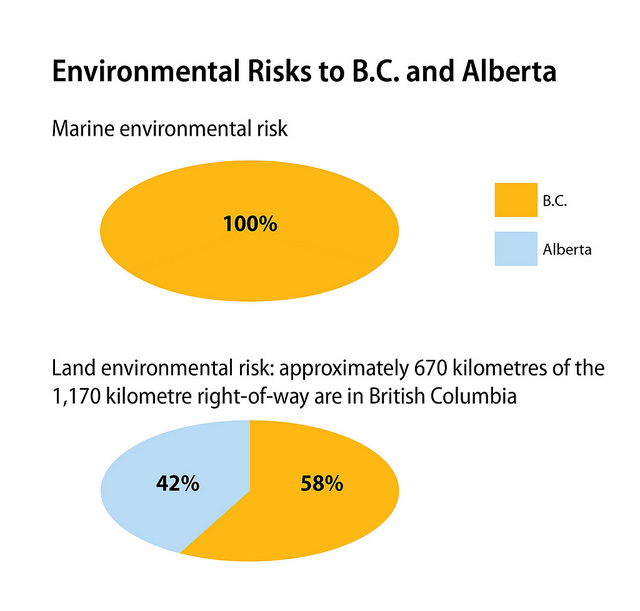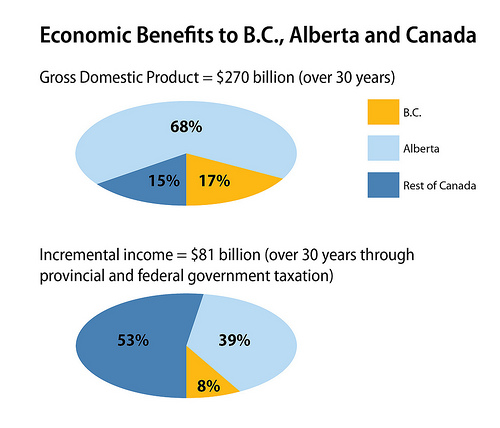Here is the background information on the BC provincial government’s policy on pipeline projects, as released July 23, by the government:
Related: BC’s desire for “world leading” marine standards collides with Harper’s C38 chain saw massacre
BACKGROUNDER 1
World-leading marine spill preparedness and response systems for British Columbia
Protecting the province’s environment is a priority for its citizens and the B.C. government. While B.C. is not the government lead in terms of responding to a marine spill, advocating for world-class protection measures and procedures is a B.C. priority. Guided by an analysis of international marine response plans and procedures, the B.C. government is moving forward with 11 recommendations to the federal government aimed at improving Ottawa’s marine spill management. Chief among those recommendations are:
Encourage the federal government to strengthen requirements for certified marine spill response organizations.
Current response times and planning capacity are less stringent than other jurisdictions like Alaska and Norway. For example, for the types of tankers being proposed for Canada’s west coast, Alaska requires planning for 300,000 barrels. In Canada, response organizations are only required to maintain response plans for spills up to approximately 70,000 barrels (10,000 tonnes).
Further, Alaska allows responders 72 hours to reach the spill site, while Canada allows 72 hours plus travel time, which can sometimes add days to the response.
Encourage the federal government to enhance tanker requirements and available response capacity.
In shared bodies of water, the United States’ requirements exceed Canada’s. For example, the United States requires escort tugs for laden tankers and mandates industry pay for designated and strategically placed emergency response tugs. Canada does not have any similar requirements.
Ensure the Canadian Coast Guard adopts a unified command/incident command structure.
The Canadian Coast Guard has a unique response system which is only used in B.C. The United States, companies and governments worldwide use a unified command/incident command response structure for a range of emergency responses, including marine spills. By bringing the Coast Guard under this system, an effective, co-ordinated response is better ensured while reducing layers of approvals that can delay critical, prompt decision-making.
Current limits of liability rules strengthened to reduce government and public exposure to financial risk.
The federal government should review its rules and requirements to ensure industry-funded response funds are sustainable and adequate to fully cover a major response without requiring public money. Currently, the total amount of ship owner insurance and industry funding available for spill response is $1.3 billion. By comparison, the U.S. federal government maintains a spill fund that is forecast to grow to nearly $4 billion by 2016.
BACKGROUNDER 2
World-Leading on-land spill preparedness and response system for British Columbia
Land-based spill response is an area where the province has significant management responsibilities. The safe transportation and use of hazardous materials – including oil and natural gas – is critical to British Columbia’s economy and way of life. While land-based spills can be mitigated, they cannot be completely avoided; they are a consequence of a modern economy.
Major resource developments in the province’s northeast, coupled with proposals to open new, and expand existing, transportation corridors for petrochemicals, makes it timely for the province to consider its spill management capacity.
B.C. government’s proposed policy:
A provincial policy review has confirmed support for the “polluter pays” principle. In other words, those sectors (i.e. the oil and gas industry) that pose the risk must be responsible for all related mitigation and response costs.
Ministry of Environment staff are in the process of reviewing options to implement industry-funded and enhanced spill-management for land-based operations. It has three central elements:
An industry-funded terrestrial spill response organization.
An enhanced provincial Environment Emergency Program.
Natural resources damages assessment.
These changes would address some key issues facing B.C.’s land-based spill response practice, including new requirements for:
industry to have tested and government-approved geographic response plans; and
provincial response capacity that matches the known risk, including staff and resources to address spills.
The proposed policy would strengthen the province’s oversight role and facilitate the verification of industry capacity. Further, it would ensure that a stable source of funding is available to ensure the program continues to have a strong presence on-scene when a spill occurs. This role for government is critical to protecting the provincial economic, social and environmental interests that can be impacted when a spill takes place.
Next steps:
Immediately strike a terrestrial spill response working group.
Engagement with key industry associations and federal agencies.
Complete in-depth technical analysis of policy and options.
Public consultation on policy intentions paper.
Draft legislation based on the chosen policy direction.
Media Contact:
BACKGROUNDER 3
Consultation and partnerships with First Nations
In British Columbia, case law requires the B.C. government to consult with First Nations on any decision that may infringe on their treaty or Aboriginal rights. Where government makes a decision that will infringe on rights, there is a legal duty called “accommodation,” which can include mitigation measures, or even economic compensation. These legal requirements impact resource development and government decision-making.
Consultation is not only a legal obligation, it is part of good governance, and the B.C. government takes consultation and the courts’ direction on consultation very seriously.
B.C.’s approach is to work in partnership to give First Nations a meaningful role in land and resource management. B.C. is also the first province to share resource development revenue with First Nations, creating opportunities that flow benefits directly back into Aboriginal communities. B.C. has reached a suite of strategic agreements that create certainty for First Nations and industry by making it easier for business and First Nations to work together.
B.C. has achieved nine Reconciliation and Strategic Engagement Agreements with First Nations. These agreements provide First Nations with a defined role in the management of lands and resources and often include tools to allow for increased First Nation participation in local economies.
B.C. has 189 active forestry revenue-sharing agreements with First Nations. Since 2003, B.C. has provided approximately $323 million and access to 63.9 million cubic metres of timber to First Nations.
B.C. signed mine revenue-sharing agreements with Nak’azdli First Nation and McLeod Lake Indian Band for the Mount Milligan Mine and the Tk’emlúps and Skeetchestn Indian bands for the New Afton Mine. Further agreements are being negotiated.
Economic Benefit Agreements with five Treaty 8 First Nations have provided $52 million to date in First Nation benefits from gas and other development in northeast B.C.
The First Nations Clean Energy Business Fund provides capacity, equity and revenue-sharing funding for First Nation participation in this sector. Since 2010, the fund has provided nearly $2.5 million to 53 First Nations.
The B.C. government has collaborated with the Business Council of British Columbia to develop the best practices to increase general understanding of industry’s role. Increasingly, companies recognize that building relationships with First Nations makes good business sense, and are taking steps to form effective relationships that result in mutual benefits.
B.C. expects proponents to build strong, enduring relationships with First Nations potentially affected by development projects. Through those relationships, there should be discussion of possible impacts on Aboriginal interests, measures in place that would mitigate those impacts and a development of impact management and benefit agreements.
BACKGROUNDER 4
Fiscal benefits imbalance: Northern Gateway Pipeline
The Northern Gateway Pipeline is forecast to provide significant benefits to governments, communities and individuals through taxation and royalty revenues, employment and indirect and induced jobs.
According to a research report by Wright Mansell Research Ltd., the pipeline is likely to generate an incremental $81 billion in provincial and federal government taxation over a 30 year period between 2016 and 2046. Of the $81 billion, a full $36 billion is accrued by the federal government.
The remaining $45 billion in provincial revenues are split with $32 billion to Alberta, $6.7 billion to British Columbia and the remaining $6 billion split among the remaining provinces, with Saskatchewan appearing to benefit by nearly $4 billion. Thus, of the $81 billion in incremental taxation revenue, British Columbia stands to receive approximately only 8.2 per cent.
The $36 billion to the federal government is anticipated to be distributed across the country on a per capita basis as these revenues would be considered to be general and not dedicated revenues. There is no guarantee these revenues would be distributed in this manner.
In addition, with the creation of a new market for Alberta oil in Asia, prices are forecast to rise such that over the same 2016-46 period, there would be a price lift of $107 billion, split $103 billion to Alberta and $4 billion to Saskatchewan, which has begun to exploit its heavy oil and bitumen resources. This lift arises from an all increased value of all oil products that are being exported out of Canada with the elimination of the discount paid for Canadian oil.
Given the risk to British Columbia from land-based and coastal bitumen spills, British Columbia does not believe an equitable distribution exists for fiscal benefits. This imbalance must be addressed prior to British Columbia considering provincial support.



